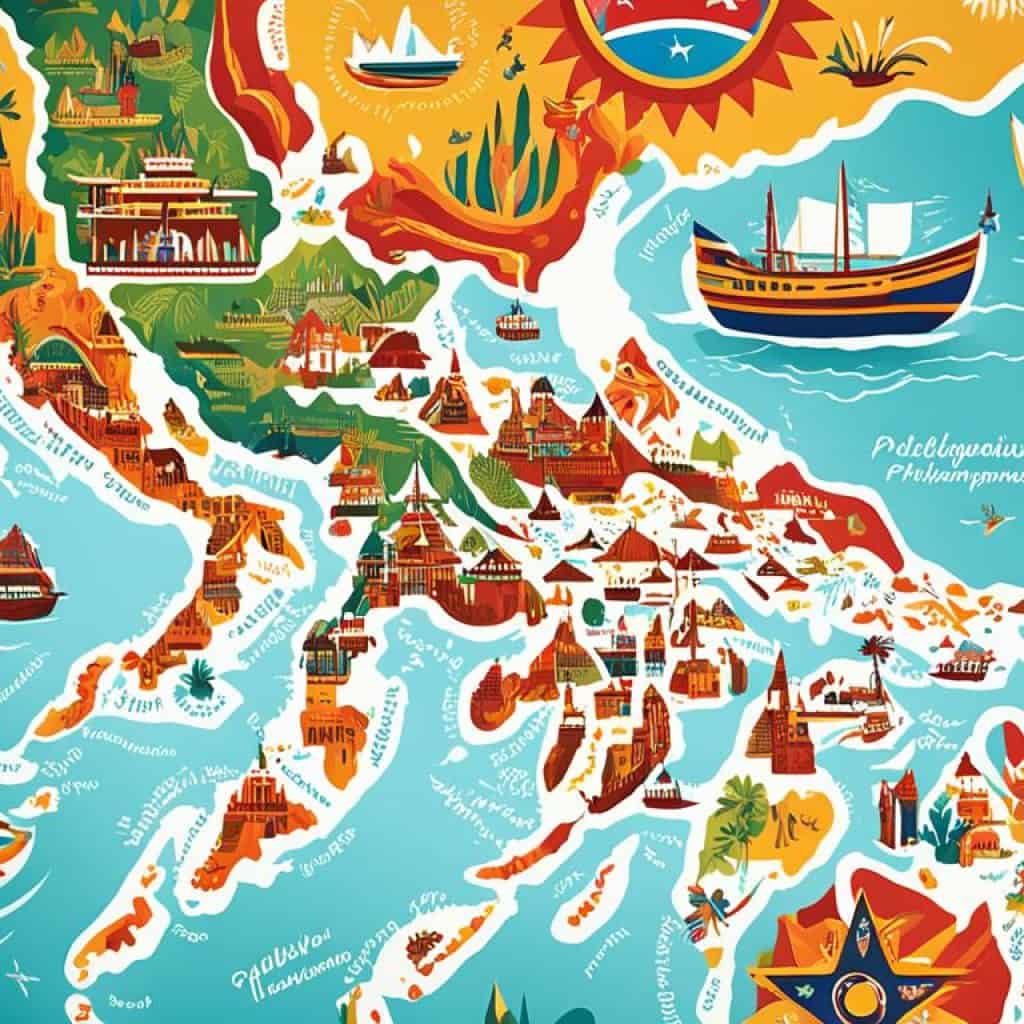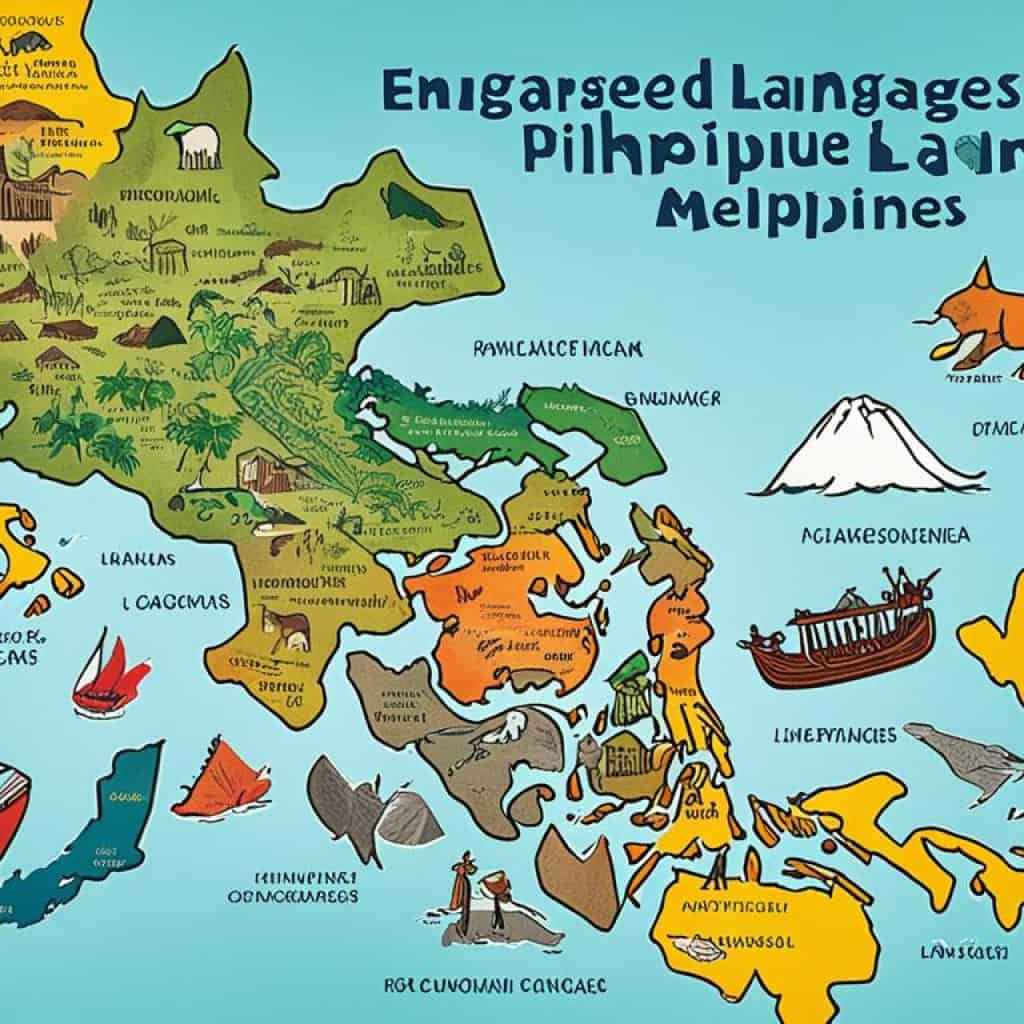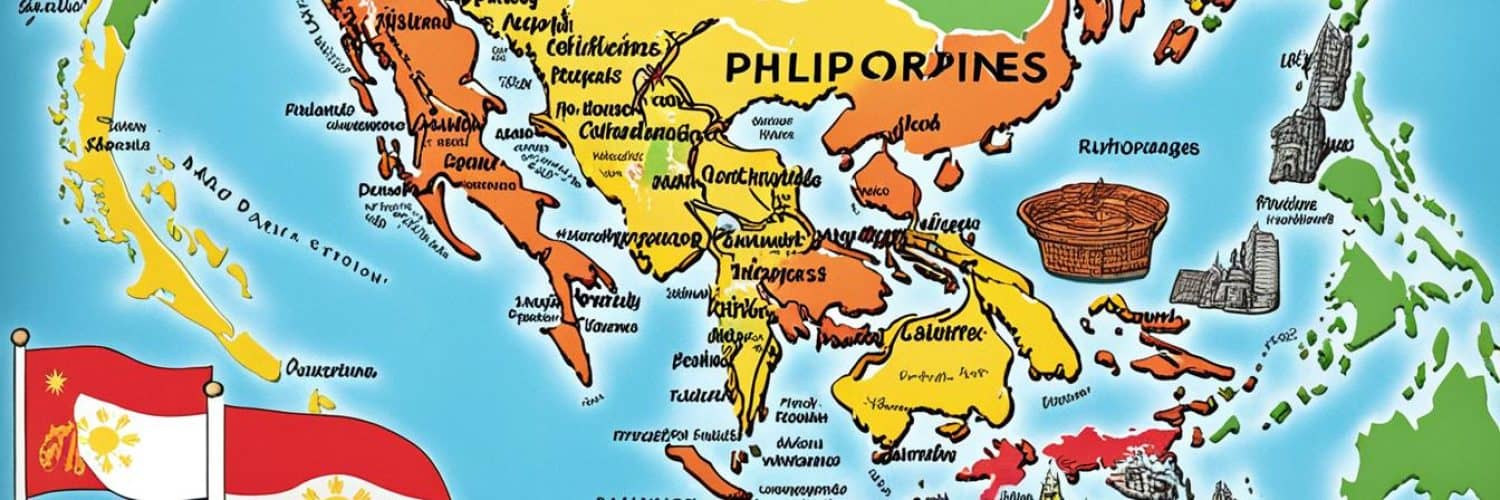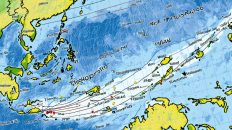Did you know that the Philippines is home to over 170 languages spoken by roughly 85 million people? This Southeast Asian archipelago has a linguistic diversity that is nothing short of astounding. From the official languages of Filipino and English to the numerous dialects spoken across the islands, language plays a crucial role in Filipino culture and identity.
Key Takeaways:
- The Philippines is home to over 170 languages spoken by roughly 85 million people.
- Filipino and English are the official languages of the country.
- The linguistic landscape of the Philippines is shaped by its history of colonization and interaction with neighboring countries.
- Tagalog, based on Filipino, serves as the national language, while English is widely used in education, government, and business.
- The Philippines’ linguistic diversity is a reflection of its rich cultural heritage and history.
Brief History of the Philippines
The history of the Philippines is a captivating tale that spans thousands of years and is characterized by various periods of colonization and struggle for independence. This rich historical backdrop has significantly shaped the languages and cultures of the archipelago.
Spanish colonization marked a pivotal era in Philippine history. It began in the 16th century and endured for 400 years, leaving an indelible mark on the country’s linguistic and religious landscape. During this time, Catholicism became the dominant religion, and Spanish influence permeated various aspects of Filipino society, including language, architecture, and customs.
“Spanish colonization brought profound changes to the Philippines, leaving behind a legacy that continues to shape the nation’s identity.”
The 19th century witnessed a period of resistance against Spanish rule, culminating in the Philippine Revolution in 1896. However, this revolution was followed by American colonization, as the United States acquired the Philippines from Spain after the Spanish-American War.
American rule brought about a new wave of influences, particularly in education and governance. The English language gained prominence and became widely used in schools, government institutions, and businesses.
“The struggle for Filipino independence was not without challenges, but it laid the foundation for the nation’s sovereignty and self-determination.”
In 1946, the Philippines finally attained independence from the United States, establishing itself as a sovereign nation. Filipino independence symbolized a triumph of the Filipino people’s aspirations for self-rule and set the stage for the country’s future development.
This historical narrative showcases the resilience and tenacity of the Filipino people in their pursuit of freedom and self-identity.
| Period | Key Events |
|---|---|
| Pre-Colonial Era | – Diverse ethnic groups inhabit the Philippine islands. – Indigenous languages flourish. – Malay traders and Chinese settlers influence local cultures. |
| Spanish Colonization | – Spanish colonization begins in the 16th century. – Spanish conquistadors establish control and spread Catholicism. – Spanish language and culture leave a lasting impact on Philippine society. |
| American Colonization | – The Philippines becomes a U.S. territory after the Spanish-American War. – English language and education systems are introduced. – Filipinos strive for self-rule and eventually gain independence. |
| Filipino Independence | – The Philippines officially becomes an independent nation in 1946. – Filipino language and culture are celebrated and promoted. – Modern Philippines emerges as a diverse and vibrant nation. |
Introduction to Linguistic Makeup of the Modern Philippines
The Philippines is a linguistic treasure trove, boasting remarkable linguistic diversity with over 170 languages spoken across its numerous islands. Among these languages, Filipino, which is based on Tagalog, stands as the most prevalent and serves as the country’s national language. In addition to Filipino, English also holds significant importance and enjoys official status.
In urban areas, Filipino is widely spoken, reflecting the cultural and linguistic vibrancy of the Philippines. This dynamic language is the key to unlocking deeper cultural connections and understanding within the country. Meanwhile, English plays a vital role in education, government affairs, and the business sector.
The linguistic landscape of the Philippines is deeply influenced by the country’s history of colonization and interaction with neighboring regions. The imprint of Spanish colonization can still be observed in the language, as Filipino incorporates loanwords from Spanish, and certain regions even have creole languages that have evolved from Spanish-based pidgins.
Exploring Language Diversity
Linguistic diversity is at the heart of the Philippines, making it a truly fascinating destination for linguistic exploration and cultural immersion.
Embracing and celebrating linguistic diversity is an integral part of Filipino culture. The prevalence of multiple languages reflects the rich history and the remarkable tapestry of cultures that make up the Philippines. This diverse linguistic landscape is a testament to the country’s resilience, adaptation, and unity in the face of different influences.
The Filipino people take pride in their languages, cherishing their uniqueness and using them as a way to express their distinct identities. The Filipino language is a testament to this, capturing the essence of the Filipino cultural heritage and serving as a unifying force among its diverse populace.
The Role of English
English, as an official language, holds immense significance in the Philippines. Its widespread usage has allowed the country to become a global hub for English language learning and proficiency.
English proficiency in the Philippines is notable, with a significant portion of the population having a high level of proficiency in the language. This proficiency extends beyond mere communication skills and covers various domains such as education, government, business, and the growing ESL industry.
English has become a gateway to numerous opportunities in the Philippines, providing access to quality education, employment prospects, and increased participation in the global community.
Preserving Linguistic Heritage
While Filipino and English may dominate the linguistic landscape, efforts are underway to preserve and protect the indigenous languages of the Philippines. Recognizing the need to safeguard these languages, initiatives have been established to document, revitalize, and promote their continued usage.
The linguistic heritage of the Philippines is seen as a cultural asset, one that reflects the country’s rich tapestry of traditions, customs, and values. By embracing and preserving linguistic diversity, the Filipino people are nurturing their cultural identity and ensuring the legacy of their ancestral languages.
Through language advocacy, cultural preservation programs, and educational initiatives, the diverse languages of the Philippines can continue to thrive, connecting generations and fostering a deep appreciation for the country’s linguistic tapestry.
Official and National Languages of the Philippines
The Philippines boasts a diverse linguistic landscape, with several major languages that contribute to its rich cultural tapestry. The official and national languages of the Philippines are:
Tagalog Language
Tagalog, based in the central area of the Philippines, takes center stage as the most widely spoken language in the country. With over 28 million native speakers, Tagalog serves as the basis for the national language, Filipino.
Cebuano Language
Cebuano, spoken in the southern parts of the country, holds significant importance with over 22 million native speakers. Known for its melodic quality, Cebuano is widely spoken in regions such as Cebu, Bohol, and parts of Mindanao.
Ilocano Language
Ilocano is spoken in the northwestern and central areas of Luzon Island. It boasts approximately 8 million native speakers and is known for its rich cultural heritage and poetic expressions.
Hiligaynon Language
Hiligaynon, spoken in Western Visayas, has a significant number of native speakers across the region. Its unique vocabulary and melodic intonation make it a distinctive language in the Philippines.
In addition to these major languages, the Philippines is home to numerous other native languages, each with its own charm and linguistic nuances. These native languages, although spoken by smaller populations, are an integral part of the linguistic diversity and cultural fabric of the Philippines.

History of the Language of the Philippines
The language history of the Philippines is a fascinating tapestry shaped by various influences. During the period of Spanish colonization, religious education was conducted in Spanish, while local dialects remained prevalent for everyday communication. This unique dynamic played a crucial role in preserving native languages and their rich linguistic traditions.
The end of Spanish colonial rule marked a significant turning point in the linguistic landscape of the Philippines. Tagalog, which is based on the language spoken by the Tagalog people in the Manila region, emerged as the most widely spoken language. The Spanish influence on Tagalog can be seen in its vocabulary, syntax, and orthography. In fact, the modern Tagalog alphabet is derived from the Spanish orthographic system. These historical ties continue to shape the language today and contribute to its unique identity.
Within the Tagalog language, there are several dialect zones that reflect the geographical and cultural diversity of the Philippines. These dialect zones represent variations in pronunciation, vocabulary, and grammar. While Tagalog serves as the basis for Filipino, the national language of the Philippines, the dialectal differences within Tagalog highlight the rich linguistic heritage of the country.
The language history of the Philippines is a testament to the resilience and adaptability of its people. Despite centuries of colonization and cultural influence, the diverse languages and dialects of the Philippines have managed to thrive and evolve, forming a linguistic tapestry that is both unique and captivating.
Tagalog Emerges as the Main Spoken Language
After centuries of Spanish colonization, Tagalog emerged as the dominant spoken language in the Philippines. The influence of Spanish on the Filipino culture and language cannot be overlooked. Following the country’s fight for independence, the need to establish a national language became evident.
In 1959, Tagalog, with its widespread usage, was selected as the basis for the Filipino language, which was adopted as the national language of the Philippines. This decision aimed to foster unity and create a common linguistic identity among the diverse population of the country.
One of the remarkable aspects of Tagalog and Filipino is their mutual intelligibility. Being closely related, a person who speaks Tagalog will have little difficulty understanding Filipino, and vice versa. This linguistic similarity has played a crucial role in facilitating communication and strengthening the sense of national identity in the Philippines.
Tagalog, as the main spoken language and the foundation for Filipino, has had a profound impact on the country’s linguistic landscape. It has become an integral part of Filipino culture, shaping daily interactions, literature, and media.
| Language | Number of Native Speakers | Region(s) Spoken |
|---|---|---|
| Tagalog | Over 28 million | Central Philippines |
| Filipino | N/A | Throughout the Philippines |
Other Languages of the Philippines
In addition to Tagalog and Filipino, there are several other major languages spoken in the Philippines. These languages contribute to the linguistic diversity of the country, reflecting its rich cultural heritage and history.
Cebuano Language
Cebuano is widely spoken in the southern parts of the Philippines, particularly in the Visayas region and Mindanao. It is the second most widely spoken language in the country, with over 18 million native speakers.
Ilocano Language
Ilocano is predominantly spoken in the northwestern and central areas of Luzon Island. It has around 8 million native speakers, making it one of the major languages of the Philippines.
Spanish Language in the Philippines
Although no longer an official language, Spanish continues to have an influence on the linguistic landscape of the Philippines. It is spoken in certain regions and has left a lasting impact on Filipino culture and language. Spanish loanwords are still present in Filipino, adding to the richness of the language.
Other Regional Languages of the Philippines
Apart from Cebuano and Ilocano, there are numerous regional languages and dialects spoken throughout the country. These languages vary from region to region, showcasing the diverse cultural and linguistic heritage of the Philippines. Some examples of other regional languages include:
- Waray
- Kapampangan
- Pangasinense
- Bicolano
The presence of these regional languages further emphasizes the Philippines’ rich tapestry of linguistic diversity.
| Language | Native Speakers | Geographical Area | Official Status |
|---|---|---|---|
| Tagalog | Over 28 million | Central regions of the Philippines | Official language and basis for Filipino |
| Cebuano | Over 18 million | Southern parts of the Philippines | Not an official language, but widely spoken |
| Ilocano | Around 8 million | Northwestern and central areas of Luzon Island | Not an official language, but widely spoken |
| Hiligaynon | Around 7 million | Western Visayas and parts of Mindanao | Not an official language, but widely spoken |
The table above highlights some major languages in the Philippines, their native speaker populations, geographical distribution, and official status, if applicable.
English Language in the Philippines
The English language holds significant importance in the Philippines as it serves as the second official language alongside Filipino. With a reputation for high English language proficiency, the majority of the population in the Philippines has varying levels of English-speaking ability. English is widely utilized across various sectors, including education, government, business, and tourism, making it a vital language for communication and advancement.
The Philippines is recognized as a top destination for English language learners, attracting individuals from around the world who seek to improve their English skills. The country’s thriving ESL (English as a Second Language) industry offers a range of language learning opportunities, including language schools and immersion programs.
The ability to speak English opens doors to academic and professional opportunities, both domestically and internationally. Many companies in the Philippines require English language proficiency for employment, and English-educated Filipinos often find themselves excelling in global job markets. English proficiency also facilitates smoother communication with international clients and partners, fostering stronger business relationships.
“English language proficiency is a gateway to success in the global arena. It equips individuals with the necessary skills to connect, collaborate, and compete on the international stage.”
Furthermore, English proficiency contributes to the growth of the tourism industry in the Philippines. English-speaking tourists can easily communicate with locals and navigate their way through the country, enhancing their travel experiences. This proficiency also creates employment opportunities within the tourism sector, serving as an engine for economic development.
The Importance of English Language Proficiency
English language proficiency plays a crucial role in empowering individuals both professionally and personally. It provides access to a wealth of knowledge through English-language resources, including books, websites, and global media. Moreover, English proficiency enables Filipinos to engage in cross-cultural exchanges and understand diverse perspectives.
The Role of English as a Second Language
English is embraced in the Philippines as a second language, reflecting the nation’s commitment to being globally connected. It bridges the gap between different linguistic communities and fosters unity among the diverse population. English as a second language allows Filipinos to communicate and interact across regional languages, fostering a sense of national cohesion.
In summary, English language proficiency holds immense importance in the Philippines. The country’s high English-speaking ability, thriving ESL industry, and recognition as a language learning destination underscore the significance of English in education, business, and everyday life.
Is Spanish Spoken in the Philippines?
During the Spanish colonial period, Spanish was the official language in the Philippines. However, its usage declined after the country gained independence. Today, Spanish is spoken by a small percentage of the population, but its influence on Filipino language and culture remains evident.
While Spanish may not be widely spoken, Spanish loanwords have enriched the Filipino vocabulary. These loanwords have become an integral part of everyday Filipino speech, blending seamlessly with native words to express a wide range of concepts and ideas.
The Influence of Spanish on Filipino Language
The Spanish influence on Filipino language is evident in the presence of numerous Spanish loanwords. These loanwords not only expanded the vocabulary of the Filipino language but also introduced new cultural concepts and practices.
- Comida (Food)
- Amigo (Friend)
- Escuela (School)
- Policía (Police)
These are just a few examples of Spanish loanwords that have seamlessly integrated into the Filipino language, enhancing its expressive capabilities.
Spanish Creole Languages and Regional Variations
While Spanish may not be spoken widely, there are regions in the Philippines where Spanish creole languages are still in use. These creole languages emerged from the interaction between Spanish and local languages, resulting in unique linguistic blends.
“Chavacano,” spoken in Zamboanga and Cavite, is a Spanish-based creole language that incorporates vocabulary from both Spanish and Filipino languages. It reflects the cultural and historical fusion of Spanish and Philippine heritage.”
The presence of Spanish creole languages in certain regions highlights the enduring legacy of Spanish in the linguistic landscape of the Philippines.
Spanish Influence on Filipino Culture
The influence of Spanish extends beyond language and permeates various aspects of Filipino culture. Spanish colonization introduced Catholicism to the Philippines, shaping religious practices and traditions. Spanish architectural styles can still be seen in historical buildings across the country.
“The Spanish influence on Filipino culture is a testament to the enduring impact of colonization. From religion to architecture, Spanish heritage is deeply woven into the fabric of Filipino identity.”
The Spanish language continues to be an important component of Filipino history and heritage, leaving a lasting imprint on the country’s culture and language.
Endangered Languages in the Philippines
Despite the linguistic diversity of the Philippines, there is a pressing issue of endangered languages. The rapid spread of Filipino and English has contributed to the decline of many indigenous languages, putting them at risk of extinction. The loss of these languages would result in the erosion of cultural diversity and the knowledge embedded within them.
However, there are active efforts to preserve and revitalize these endangered languages. Language documentation initiatives aim to record and analyze the grammar, vocabulary, and pronunciation of endangered languages to create comprehensive language resources. These resources serve as valuable references for future language revitalization efforts.
Cultural preservation initiatives also play a crucial role in safeguarding indigenous languages. These initiatives involve supporting native language speakers, organizing language-related events, and encouraging language use in traditional cultural practices. By fostering a sense of pride and value for indigenous languages, these initiatives help revitalize interest and promote their survival.
Education programs focused on indigenous language revitalization are being implemented in schools and communities. These programs aim to incorporate indigenous languages into the curriculum, creating opportunities for the younger generation to learn and embrace their ancestral languages. Additionally, community-based language classes and language immersion programs provide immersive learning experiences, allowing individuals to develop fluency and actively engage with indigenous languages.
Preserving and revitalizing indigenous languages is paramount not only for the linguistic heritage of the Philippines but also for the cultural identity of its diverse communities. By recognizing the value of these languages and actively supporting their preservation, we can ensure the continued survival and celebration of the rich linguistic tapestry that makes the Philippines unique.

Learning Languages in the Philippines
With its linguistic diversity, the Philippines offers a unique and immersive language learning experience. Language schools and immersion programs can be found across the country, providing opportunities to study both Filipino and English, as well as other major languages spoken in the Philippines. Whether you’re interested in mastering Tagalog, Cebuano, Ilocano, or Hiligaynon, there are resources available to suit your language learning needs.
“For language enthusiasts and aspiring polyglots, the Philippines is a treasure trove of language study opportunities. The multicultural environment allows students to practice their language skills with native speakers and gain a deeper understanding of the rich cultural heritage of each language.”
Language schools in the Philippines offer a structured approach to language learning, combining classroom instruction with practical application. These schools employ experienced teachers who are native speakers of the language, ensuring a high-quality learning experience. Many schools also offer flexible programs, ranging from short-term intensive courses to long-term study options.
In addition to language schools, immersion programs provide a unique way to learn a language while experiencing the local culture. Immersion programs offer participants the opportunity to live with local families, attend language classes, and engage in cultural activities. This immersive environment fosters rapid language acquisition and a deeper appreciation for the nuances of the language.
Whether you choose a language school or an immersion program, studying a language in the Philippines is more than just learning grammar and vocabulary. It is an experience that allows you to connect with the local community, understand their way of life, and gain a deeper appreciation for the language as an integral part of Filipino culture.
Benefits of Learning Languages in the Philippines:
- Immersive language learning experience.
- Opportunity to interact with native speakers.
- Study programs tailored to different language levels and goals.
- Exposure to diverse linguistic and cultural perspectives.
- Chance to explore the country’s rich cultural heritage.
Language Schools and Immersion Programs in the Philippines:
| Language School or Program | Location |
|---|---|
| ABC Language School | Manila |
| Lingua Franca Institute | Cebu City |
| Tagalog Immersion Program | Quezon City |
| Ilocano Language School | Laoag |
These are just a few examples of the language schools and immersion programs available in the Philippines. Depending on your language of interest and preferred location, you can find a variety of options to suit your needs.
Learning a language in the Philippines not only expands your linguistic abilities but also opens doors to new cultural experiences and personal growth. So why not embark on a language learning journey in the vibrant and diverse setting of the Philippines?
Importance of Language in Filipino Culture
Language is an integral part of Filipino culture, intricately woven into the country’s history, identity, and sense of unity. It serves as a powerful tool that connects generations, preserves tradition, and fosters a deep sense of belonging. Language preservation initiatives play a vital role in safeguarding the unique cultural heritage of the Philippines, ensuring that the diverse range of languages and dialects continues to thrive as a valuable cultural asset and a source of immense pride.
Language serves as a living testament to the rich tapestry of the Filipino people, reflecting the influences of the country’s history, colonization, and vibrant interactions with neighboring cultures. Each language carries its own nuances, expressions, and wisdom, encapsulating the shared experiences, values, and beliefs of its speakers.
Language is the road map of a culture. It tells you where its people come from and where they are going. – Rita Mae Brown
Through language, the Filipino culture is expressed, celebrated, and passed down from one generation to the next. It serves as a conduit for storytelling, folklore, proverbs, and traditional practices, encapsulating the wisdom and experiences of ancestors. Language holds the key to understanding the diverse cultural tapestry of the Philippines, providing insights into local customs, traditions, and ways of life.
Language preservation initiatives are essential to ensure that the cultural heritage embedded within each language continues to thrive. These initiatives encompass a range of activities, including language documentation, education programs, cultural preservation efforts, and community engagement. By actively preserving and promoting indigenous languages, the Filipino people uphold their cultural identity and contribute to the collective heritage of humanity.
The Cultural Asset of Language Diversity
The linguistic diversity of the Philippines is seen as a cultural asset, representing the country’s multiculturalism, resilience, and rich heritage. The multitude of languages and dialects spoken across the archipelago highlights the deep-rooted history and the continuous evolution of Filipino culture.
The table below showcases some of the major languages of the Philippines, along with their respective native speakers:
| Language | Native Speakers |
|---|---|
| Tagalog | Over 28 million |
| Cebuano | Over 22 million |
| Ilocano | Around 8 million |
| Hiligaynon | Around 7 million |
| …and many more | … |
The diverse languages spoken in the Philippines reflect the country’s regional and cultural differences, allowing for a deeper understanding and appreciation of its people. Each language carries its own unique history, dialects, and intricacies, contributing to the vibrant mosaic of Filipino culture.
Understanding and celebrating the linguistic diversity of the Philippines fosters pride, unity, and cultural exchange. It serves as a reminder of the importance of language preservation, highlighting the need to protect and nurture these invaluable cultural treasures.
Languages in the Digital Age
The digital age has brought significant advancements in language learning and access to language services. With the help of digital resources, language apps, and online language courses, learning Filipino and other languages has become more convenient and accessible. These digital tools have opened up new opportunities for individuals interested in developing their language skills.
Language apps are one of the most popular ways to learn a language in the digital age. These apps provide interactive lessons, language exercises, and immersive content that make language learning engaging and interactive. Whether you want to learn vocabulary, practice grammar, or improve your pronunciation, language apps offer a range of features to suit your learning needs.
Online language courses are another valuable resource for language learners. These courses provide structured lessons taught by qualified instructors, allowing learners to study at their own pace and interact with fellow students. Online language courses offer a flexible learning environment that fits into busy schedules and provides opportunities for live discussions, feedback, and assessments.
Language services, such as translation and interpretation, have also been transformed by the digital age. The availability of online platforms and cloud-based tools has made language services more accessible and efficient. Individuals and businesses can now easily connect with professional translators and interpreters for their language needs. This has facilitated cross-cultural communication, enabling businesses to expand their reach and individuals to bridge linguistic barriers.
Overall, the digital age has revolutionized language learning and language services, making them more accessible, interactive, and convenient. Whether you are a language learner or in need of language services, the digital landscape offers a wide range of resources to support your language journey.

Advantages of Digital Language Learning Resources:
- Accessible anytime, anywhere with an internet connection
- Interactive and engaging learning experience
- Varied content formats, including audio, video, and interactive exercises
- Individualized learning paths and progress tracking
- Instant feedback and corrections
Examples of Popular Language Apps:
| Language App | Description |
|---|---|
| Duolingo | Offers gamified lessons and personalized learning paths for over 30 languages. |
| Rosetta Stone | Provides language learning programs designed to enhance speaking, listening, and writing skills. |
| Babbel | Focuses on practical conversational skills and offers courses in various languages. |
Benefits of Online Language Courses:
- Structured curriculum and expert guidance
- Flexibility to learn at your own pace
- Opportunity to interact with instructors and fellow learners
- Access to additional learning materials and resources
- Recognition of completion through certificates or diplomas
Language Services in the Philippines:
“The Philippines is a hub for language services, offering a range of translation, interpretation, and localization solutions. With a highly-educated workforce and proficiency in English, Filipino, and other languages, language service providers in the Philippines deliver quality and culturally-appropriate content for global audiences.”
– Juan Dela Cruz, CEO of LinguaCorp
Language as a Gateway to Filipino Culture
Immersing oneself in the local language is a powerful way to unlock the treasures of Filipino culture. By learning the language, travelers can go beyond surface-level experiences and delve into the heart of a rich and diverse heritage. Whether it’s exploring local customs, participating in traditional celebrations, or simply conversing with locals, language skills open doors to a deeper understanding of the Filipino way of life.
When travelers make an effort to learn the language, they gain a unique perspective on the cultural nuances that shape Filipino society. From understanding the meaning behind traditional greetings to immersing oneself in local customs, language learning provides a meaningful cultural immersion experience. By embracing the language, travelers can develop a deep appreciation for the customs, traditions, and values that define Filipino society.
Language also plays a crucial role in facilitating connections with locals. When travelers make an effort to learn and use the local language, doors open to authentic interactions and meaningful connections. Locals appreciate the effort and are often more open and welcoming, providing a window into Filipino hospitality and warmth. Communicating in the local language fosters a sense of belonging and demonstrates respect for the local culture.
Travelers who have a command of the local language can also enhance their travel experiences. By being able to communicate effectively, they can navigate through markets, order local delicacies, and seek recommendations from locals. This not only adds convenience but also allows travelers to discover hidden gems and experience the true essence of the destination. Language proficiency empowers travelers to explore off-the-beaten-path locations and engage in authentic cultural experiences.
Language learning is not just about acquiring a new skill; it is a journey of cultural discovery. It opens doors to a deeper understanding of Filipino customs, traditions, and ways of life. Embrace the language, and let it serve as your gateway to the heart of Filipino culture.
The Importance of Language and Local Customs
Language and local customs are intricately intertwined in Filipino culture. Language is more than just a means of communication; it reflects the values, history, and identity of a people. By understanding the language, travelers gain insights into Filipino customs and traditions, such as the significance of respect for elders, the importance of family ties, and the value placed on community. Language is the key to unlocking the rich tapestry of Filipino culture.
For example, learning Tagalog opens the door to understanding the richness of Filipino idioms and expressions. These linguistic gems provide glimpses into the Filipino worldview, reflecting their unique perspectives and cultural values. From “bahala na” (leave it to God) to “kilig” (butterflies in the stomach), these words and phrases capture the essence of Filipino emotions and experiences. Language enables travelers to connect on a deeper level and appreciate the subtleties of Filipino customs and expressions.
Language and local customs go hand in hand, shaping the way Filipinos interact and engage with one another. Understanding the local language allows travelers to navigate social situations with ease, be it attending local festivals, participating in community activities, or engaging in everyday conversations. Language proficiency promotes cultural sensitivity and fosters meaningful connections, creating bridges between different cultures and fostering mutual understanding.
Language and Travel in the Philippines
The Philippines is a destination that offers a plethora of opportunities to explore and engage with its diverse culture. Language learning enriches the travel experience, allowing visitors to fully immerse themselves in the beauty and vibrancy of Filipino society. Whether it’s embarking on language study programs, enrolling in language schools, or participating in language immersion programs, travelers have various avenues for language acquisition.
Language schools in the Philippines cater to both local and international students, offering comprehensive language programs tailored to individual needs. These institutions provide a supportive learning environment, enabling students to develop their language skills while gaining insights into Filipino culture. Classroom learning is often supplemented with immersive experiences, such as cultural activities, field trips, and interactions with native speakers.
Language immersion programs offer a unique opportunity for travelers to live with a local family, engage in everyday activities, and practice their language skills in authentic settings. These programs provide a deep dive into Filipino culture, allowing participants to witness firsthand the intricacies of daily life and develop a deep appreciation for the customs and traditions of the host community.
Language and travel are inseparable when exploring the Philippines. Whether it’s uncovering the historical significance of language through visits to language museums or engaging in language-focused cultural tours, travelers can embark on a transformative journey that not only expands their linguistic abilities but also deepens their understanding of Filipino culture.
Language and Local Customs
Language and local customs are closely intertwined in the colorful tapestry of Filipino culture. Learning the language allows travelers to navigate the nuances of social interactions, understand cultural norms, and appreciate the significance of local customs.
For instance, the use of honorifics and polite forms of speech is deeply ingrained in Filipino language and culture. Addressing elders or individuals in positions of authority with respect is a common practice. By understanding and using these cultural nuances in language, travelers show reverence and consideration, fostering positive connections and cultural exchange.
Language proficiency also allows travelers to participate in traditional customs and rituals. For example, during Filipino fiestas, knowledge of the local language enables visitors to sing traditional songs, join in folk dances, and understand the stories behind these rituals. By actively participating, travelers can authentically engage in local traditions, fostering cross-cultural understanding and appreciation.
Language and local customs illuminate the path to a deeper appreciation of Filipino heritage. By embracing the language and immersing oneself in local customs, travelers gain a holistic understanding of the rich and diverse Filipino culture, forging lasting connections and treasured memories along the way.
Conclusion
The linguistic diversity of the Philippines is a testament to its vibrant cultural heritage and fascinating history. With Filipino and English serving as official languages and a multitude of indigenous languages adding to the linguistic tapestry, the country is a true melting pot of languages. It is essential to prioritize language learning and preservation efforts to safeguard and celebrate this unique linguistic heritage.
As the Philippines continues to grow and evolve, language remains a vital element in shaping Filipino identity and fostering cross-cultural understanding. Language learning provides a gateway to deeper insights into Filipino culture, customs, and ways of life. By immersing oneself in the languages spoken in the Philippines, learners can enhance their travel experiences, forge meaningful connections, and gain a greater appreciation for the country’s rich cultural and linguistic heritage.
The digital age has opened up new possibilities for language learning and accessibility to language services. With the abundance of digital resources, language apps, and online language courses, individuals can now learn Filipino and other languages at their own pace and convenience. These advancements in technology also facilitate easier cross-cultural communication, allowing people from different linguistic backgrounds to connect and understand one another.
Language preservation initiatives and cultural immersion through language learning are crucial in preserving the linguistic diversity and cultural heritage of the Philippines. By recognizing the value of the country’s myriad of languages, we can honor and protect the indigenous languages at risk of extinction. Language is not solely a means of communication; it embodies the essence of a culture and provides a platform for cultural exchange and understanding.














Add comment